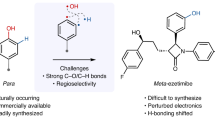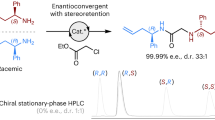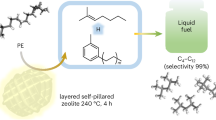Abstract
Industrially, aldehydes are produced annually on a multimillion-tonne scale via the hydroformylation of olefins with syngas (CO/H2 mixture). Nonetheless, this transformation has not found frequent use in the laboratory. Here we report on a simple strategy for the concerted generation of syngas from two accessible and crystalline main element compounds with just water as the primary activator for syngas release. By decoupling the syngas formation and consumption via a two-chamber reactor we demonstrate this low-pressure, low-temperature and near-stoichiometric hydroformylation operates efficiently on a diverse array of terminal olefins without the need for expensive equipment. Our approach provides unique opportunities to access aldehydes in a safe and reliable manner with further adaptation to the synthesis of a range of pharmaceuticals and relevant molecules thereof. This strategy is adaptable to carbon isotope labelling as demonstrated by the use of a 13CO releasing molecule. We anticipate this hydroformylation approach will provide a complementary toolbox for drug discovery and development.

This is a preview of subscription content, access via your institution
Access options
Access Nature and 54 other Nature Portfolio journals
Get Nature+, our best-value online-access subscription
$29.99 / 30 days
cancel any time
Subscribe to this journal
Receive 12 digital issues and online access to articles
$119.00 per year
only $9.92 per issue
Buy this article
- Purchase on Springer Link
- Instant access to full article PDF
Prices may be subject to local taxes which are calculated during checkout






Similar content being viewed by others
Data availability
The data in support and related to this study is available in the Supplementary Information. Additional data are available from the authors on reasonable request.
References
Franke, R., Selent, D. & Börner, A. Applied hydroformylation. Chem. Rev. 112, 5675–5732 (2012).
Börner A. & Franke, R. Hydroformylation. Fundamentals, Processes, and Applications in Organic Synthesis (Wiley-VCH, 2016).
Taddei, M. & Mann, A. (eds) Hydroformylation for Organic Synthesis (Springer, 2013).
van Leeuwen, P. W. N. M. & Claver, C. (eds) Rhodium Catalyzed Hydroformylation (Kluwer Academic, 2000).
Whiteker G. T. & Cobley C. J. Organometallics as Catalysts in the Fine Chemical Industry. Topics in Organometallic Chemistry (eds Beller M. & Blaser H. U.) Vol. 42 (Springer, 2012).
Cornils, B., Herrmann, W. A., Beller, M. & Paciello, R. (eds) Applied Homogeneous Catalysis with Organometallic Compounds (Wiley‐VCH, GmbH & Co., 2018).
Kämper, A. et al. Ruthenium-catalyzed hydroformylation: from laboratory to continuous miniplant scale. Cat. Sci. Tech. 6, 8072–8079 (2016).
Behr, A. & Neubert, P. Applied Homogeneous Catalysis (Wiley-VCH, 2012).
Wu, L., Liu, Q., Jackstell, R. & Beller, M. Carbonylation of alkenes with CO surrogates. Angew. Chem. Int. Ed. 53, 6310–6320 (2014).
Morimoto, T. & Kakiuchi, K. Evolution of carbonylation catalysis: no need for carbon monoxide. Angew. Chem. Int. Ed. 43, 5580–5588 (2004).
Ren, W. et al. An effective Pd-catalyzed regioselective hydroformylation of olefins with formic acid. J. Am. Chem. Soc. 138, 14864–14867 (2016).
Christensen, S. H., Olesen, E. P. K., Rosenbaum, S. & Madsen, R. Hydroformylation of olefins and reductive carbonylation of aryl halides with syngas formed ex situ from dehydrogenative decarbonylation of hexane-1,6-diol. Org. Biomol. Chem. 13, 938–950 (2015).
Verendel, J. J., Nordlund, M. & Anderson, P. G. Selective metal-catalyzed transfer of H2 and CO from polyols to alkenes. ChemSusChem 6, 426–429 (2013).
Hermange, P. et al. Ex situ generation of stoichiometric and substoichiometric 12CO and 13CO and its efficient incorporation in palladium catalyzed aminocarbonylations. J. Am. Chem. Soc. 133, 6061–6071 (2011).
Friis, S. D., Lindhardt, A. T. & Skrydstrup, T. The development and application of two-chamber reactors and carbon monoxide precursors for safe carbonylation reactions. Acc. Chem. Res. 49, 594–605 (2016).
Gautam, P. & Bhanage, B. M. Recent advances in the transition metal catalyzed carbonylation of alkynes, arenes and aryl halides using CO surrogates. Catal. Sci. Technol. 5, 4663–4702 (2015).
Demaerel, J. & Veryser, C. & De Borggraeve, W. M. Ex situ gas generation for lab scale organic synthesis. React. Chem. Eng. 5, 615–631 (2020).
Elmore, C. S. & Bragg, R. A. Isotope chemistry: a useful tool in the drug discovery arsenal. Bioorg. Med. Chem. Lett. 25, 167–171 (2015).
Nielsen, D. U., Neumann, K. T., Lindhardt, A. T. & Skrydstrup, T. Recent developments in carbonylation chemistry using [13C]CO, [11C]CO, and [14C]CO. J. Lab. Comp. Radiopharm. 61, 949–987 (2018).
Flinker, M. et al. Efficient water reduction with sp3–sp3 diboron(4) compounds: application to hydrogenations, H–D exchange reactions and carbonyl reductions. Angew. Chem. Int. Ed. 56, 15910–15915 (2017).
Friis, S. D., Taaning, R. H., Lindhardt, A. T. & Skrydstrup, T. Silacarboxylic acids as efficient carbon monoxide releasing molecules: synthesis and application in palladium catalyzed carbonylation reactions. J. Am. Chem. Soc. 133, 18114–18117 (2011).
Frohliger, J. O., Dziedzic, J. E. & Steward, O. W. Simplified spectrophotometric determination of acid dissociation constants. Anal. Chem. 42, 1189–1191 (1970).
Wartik, T. & Apple, E. F. The reactions of diboron tetrachloride with some hydrogen compounds of nonmetallic elements and with dimethyl sulfide. J. Am. Chem. Soc. 80, 6155–6158 (1958).
Seiche, W. & Breit, B. Hydrogen bonding as a construction element for bidentate donor ligands in homogeneous catalysis: regioselective hydroformylation of terminal alkenes. J. Am. Chem. Soc. 125, 6608–6609 (2003).
Seiche, W. & Breit, B. Self‐assembly of bidentate ligands for combinatorial homogeneous catalysis based on an A–T base-pair model. Angew. Chem. Int. Ed. 44, 1640–1643 (2005).
Seiche, W., Schuschkowski, A. & Breit, B. Bidentate ligands by self-assembly through hydrogen bonding: a general room temperature/ambient pressure regioselective hydroformylation of terminal alkenes. Adv. Synth. Catal. 347, 1488–1494 (2005).
Gellrich, U., Seiche, W., Keller, M. & Breit, B. Mechanistic insights into a supramolecular self‐assembling catalyst system: evidence for hydrogen bonding during rhodium-catalyzed hydroformylation. Angew. Chem. Int. Ed. 51, 11033–11038 (2011).
Brown, C. K. & Wilkinson, G. Homogeneous hydroformylation of alkenes with hydridocarbonyltris(triphenylphosphine)rhodium(i) as catalyst. J. Chem. Soc. A 2753–2764 (1970).
Wuts, P. G. M., Obrzut, M. L. & Thompson, P. A. Hydroformylation as a simple and efficient one carbon homologation of homoallylic alcohols. synthesis of prelog-djerassi lactone. Tetrahedron Lett. 25, 4051–4054 (1984).
Bates, R. W., Sivarajan, K. & Straub, B. F. A synthesis of pseudoconhydrine and its epimer via hydroformylation and dihydroxylation. J. Org. Chem. 76, 6844–6848 (2011).
Nordeman, P. et al. Rapid and efficient conversion of (11) CO2 to (11) CO through silacarboxylic acids: applications in Pd-mediated carbonylations. Chem. Eur. J. 21, 17601–17604 (2015).
Schellekens, R. C. A., Stellaard, F., Woerdenbag, H. J., Frijlink, H. W. & Kosterink, J. G. W. Applications of stable isotopes in clinical pharmacology. Br. J. Clin. Pharmacol. 72, 879–897 (2011).
Solon, E. G., Balani, S. K. & Lee, F. W. Whole-body autoradiography in drug discovery. Curr. Drug Metab. 3, 451–462 (2002).
Harrington, P. J. & Lodewijk, E. Twenty years of naproxen technology. Org. Proc. Res. Dev. 1, 72–76 (1997).
Dahlström, M., Mårtensson, L. G. E., Jonsson, P. R., Arnebrant, T. & Elwing, H. Surface active adrenoceptor compounds prevent the settlement of cyprid larvae of Balanus improvises. Biofouling 16, 191–203 (2000).
Chiou, W.-H., Lin, G.-H., Hsu, C.-C., Chaterpaul, S. J. & Ojima, I. Efficient syntheses of crispine A and harmicine by Rh-catalyzed cyclohydrocarbonylation. Org. Lett. 11, 2659–2662 (2009).
Zhang, Q., Tu, G., Zhao, Y. & Cheng, T. Novel bioactive isoquinoline alkaloids from Carduus crispus. Tetrahedron 58, 6795–6798 (2002).
Acknowledgements
The research reported in this publication was supported by the Danish National Research Foundation (award no. DNRF118), NordForsk (award no. 85378) and Aarhus University.
Author information
Authors and Affiliations
Contributions
S.K.P., H.G.G., D.U.N., B.S.D., K.D. and H.C.D.H developed the syngas release and the catalytic reactions. S.K.P., D.U.N., H.G.G. and T.S conceived and designed the investigations. T.S. directed and supported the research. S.K.P, H.G.G. and T.S. wrote the manuscript.
Corresponding author
Ethics declarations
Competing interests
T.S. is co-owner of SyTracks a/s, which commercializes the two-chamber technology and silacarboxylic acid 2.
Additional information
Publisher’s note Springer Nature remains neutral with regard to jurisdictional claims in published maps and institutional affiliations.
Supplementary information
Supplementary Information
Supplementary Methods, Figs. 1–24, Table 1, NMR spectra and references.
Rights and permissions
About this article
Cite this article
Pedersen, S.K., Gudmundsson, H.G., Nielsen, D.U. et al. Main element chemistry enables gas-cylinder-free hydroformylations. Nat Catal 3, 843–850 (2020). https://doi.org/10.1038/s41929-020-00510-z
Received:
Accepted:
Published:
Issue Date:
DOI: https://doi.org/10.1038/s41929-020-00510-z
This article is cited by
-
A triple tandem reaction for the upcycling of products from poorly selective CO2 photoreduction systems
Nature Synthesis (2024)
-
Multi-carbon labelling of active pharmaceutical ingredients enabled by a three-gas surrogate hydroformylation
Nature Synthesis (2023)
-
A practical concept for catalytic carbonylations using carbon dioxide
Nature Communications (2022)



